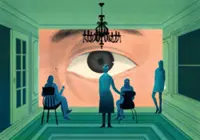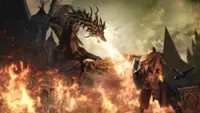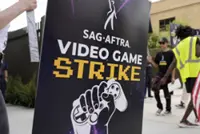
Giant Sparrow’s most recent release, What Remains Of Edith Finch, is one of the more piquant fusions of narrative and game design of the past decade. — Photos: Giant Sparrow
Ian Dallas, the founder and creative director of video game studio Giant Sparrow, happened to be talking about food, but his gastronomical tastes are similar to his design philosophy. “I’m always interested,” he said, “in what’s the strangest, new intense experience that I can have.”
Giant Sparrow’s most recent release, What Remains Of Edith Finch, is one of the more piquant fusions of narrative and game design of the past decade. What became a collection of short stories about a cursed family of storytellers living in the Pacific Northwest began as a scuba diving simulator.
From the rough prototype to the finished game, Dallas strove to evoke the rush of the sublime; while searching for ways to conjure that feeling, he made one prototype after another. By the alchemy of art, he and his small team ended up with a game that uses a different mechanic for each of the stories it tells about the last day of a character’s life.
In one scenario, a little girl turns into a cat, an owl, a shark and a man-eating sea monster; in another, a man working at a cannery becomes lost in an internal fantasy while working over a fish-slicing machine.
Dallas’ approach to a project can be summed up as experimentation within a given set of parameters. He likes to tell new colleagues that he wants to see things he will hate.
“If I don’t see ideas that include some that are just like really out there, then we’re not trying hard enough,” he said. What might not seem promising early on can plant the seed for inspired creativity down the line.
A couple of years after the success of What Remains Of Edith Finch, in January 2019, Dallas started working on a bird simulator prototype to try to get the ideas flowing. He had a long-standing interest in birds. But as with the scuba diving prototype from years before, he did not have an inkling where the idea would take him.
Now Giant Sparrow’s three-person team is working in six-week sprints to put together prototypes and gather feedback on its next game, which will also be framed around a collection of short stories. The unnamed game is about a field biologist who studies animals and will explore “the strangeness of organic life”, Dallas said during a video chat from his Los Angeles office.
Dallas majored in film as an undergraduate at Yale University and spent some time working in television, but he had his eye on writing video games. The more he researched the industry, however, the more he realised that video game writers have little say on the direction a project will take.
“All of the important decisions are made upstream,” he said.
To better position himself, Dallas enrolled at the University of Southern California, where he studied game design and spent a couple of years developing prototypes. One caught the attention of Sony, and he secured a deal to develop it into a full game.
Dallas dropped out of his master’s program and formed his own company in 2009. Three years later he released The Unfinished Swan (2012), about a young boy who explores a semi-realised kingdom. It won BAFTA Awards for best debut and game innovation, and What Remains Of Edith Finch (2017) won best narrative at the Game Awards and the BAFTA for best game.
Past success does not guarantee that future projects will be smooth. Ask just about any video game developer what it is like to see a project through from start to finish and you will learn about false starts, heartbreaking overhauls and late-stage revisions. The next game by Giant Sparrow – Dallas likens each iteration of his studio to a band that exists to make an album – has been no different.
“The original premise for the game was a mix of David Attenborough and Spirited Away,” Dallas said, referring to the British biologist whose plummy voice narrates documentaries like The Blue Planet, and Hayao Miyazaki’s Oscar-winning animated film.
One of the “early catastrophes” in the design process was Dallas’ disappointing realisation about nature documentaries. Instead of finding inspiration, he was dismayed by how many adhered to a formula of focusing on an area for a few minutes before radically shifting to another geography and climate. “They work in part because it’s like a distraction for a toddler,” he said.
It has also been challenging, Dallas said, to design gameplay systems more interesting than what one might expect from the premise – “like a photographing mini game, or like collecting 10 ladybugs or whatever.”
To partially get around this problem, he plans to introduce a number of fantastical creatures. It has been tricky to distinguish them, though, given the monstrous appearance of real animals like star-nosed moles and anglerfish. “Scary can also be boring,” he wrote in an email. The right direction, he said, was a mutton-chopped monster created by one of Giant Sparrow’s concept artists.
“When we started adding a few slightly goofy elements,” Dallas said, “that led us to some stranger and more interesting places.”
Dallas wants his new game to help people reflect on the vastly different ways that other species experience the world. He is also interested in “how many bizarre things are going on around us all the time that we aren’t really aware of or thinking about.”
He continued, “This game is trying to call out just how weird biology is.”
The intention is for players to feel a push and pull between themselves and the game world. Dallas pointed to a sequence in which players must try to get something stuck on a giraffe’s head, while also coaxing the animal to draw near and angle its head just so.
“I think single-player games often feel like a chess board – a world that’s highly predictable and entirely designed to facilitate the limited set of actions a player is capable of,” Dallas wrote. “We’d like our worlds to feel more exploratory and playful.”
What seems playful, though, can vary in relation to its surroundings. In one chapter of What Remains Of Edith Finch, players assume the role of a baby in a bathtub. The segment was not that emotionally difficult when he first tested it, Dallas said. But it assumes a completely different force in the actual game, he said, “after having played an hour of other stories where you know that every person in this game is going to die.”
Similarly to What Remains Of Edith Finch, the tone of Giant Sparrow’s next game has considerably darkened over its development cycle. Dallas said his team initially tried to capture how mesmerising animals were, and did not incorporate people at all in early zoology-themed prototypes.
“What we have slowly found our way to is a game where animals feel gross and maybe you have this visceral reaction to, in the way that like, when a caterpillar walks over your finger there’s something about all those legs moving that’s really disturbing but also fascinating,” Dallas said.
To that end, elements of poop and biological decay have become integrated into the game. Dallas is also trying to work in a bit involving caterpillars, which turn themselves into liquid to transform into butterflies. Children are taught to consider the transformation adorable, but he calls it one of the most horrifying processes in nature.
“Hopefully, this game is going to be one of the stranger games that people have experienced,” Dallas said. “I’m doing everything I can to make it that way.” – ©2024 The New York Times Company










































